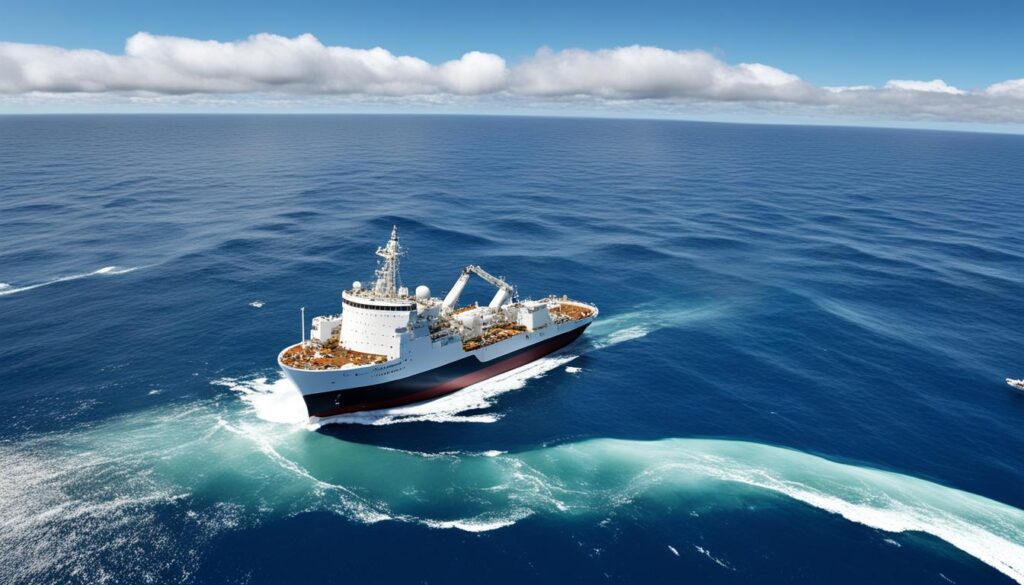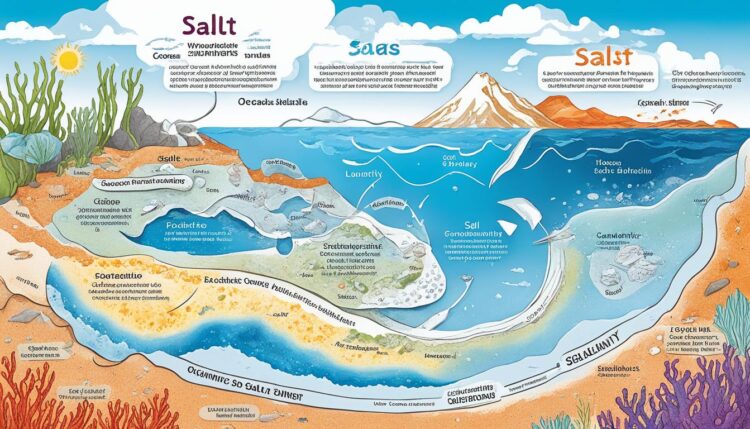Ocean salinity is a fundamental element in understanding marine biology and the behavior of our oceans. Significantly affecting the density and circulation of ocean water, ocean salinity also plays a pivotal role in our global water cycle. Through sea surface salinity observations, like those visualized by NASA from September 2011 to September 2014, we gain insights into the global patterns and variations of salinity.
The study of ocean salinity importance extends beyond just marine biology. It helps scientists understand broader environmental processes influencing weather, climate, and life on Earth. As salt primarily contributes to seawater’s properties, analyzing its distribution and effects is critical for comprehensive oceanographic studies.
Key Takeaways
- Ocean salinity is vital for marine biology and environmental processes.
- It influences the density and circulation of ocean water.
- Salinity plays a crucial role in the global water cycle.
- NASA’s sea surface salinity observations provide valuable data.
- Understanding salinity helps in broader climatic and oceanographic studies.
Understanding Ocean Salinity
Ocean salinity, a critical parameter in marine science, provides valuable insights into the water’s chemical composition and physical properties. Let’s explore what ocean salinity is and the techniques used to measure it.
What is Ocean Salinity?
Ocean salinity definition refers to the concentration of dissolved salts in a given volume of seawater, which is typically expressed in parts per thousand (ppt). This measure helps in understanding various seawater characteristics, including its density, ability to conduct electricity, and freezing point. The average ocean salinity is about 35 ppt, though it can vary based on geographic location, depth, and seasonal changes.
How Salinity is Measured
Several salinity measurement techniques are employed to determine the salt concentration in seawater accurately. One traditional method involves collecting water samples and analyzing the quantity of dissolved salts in a laboratory. More modern approaches involve instruments like conductivity sensors and refractometers, which provide real-time data on salinity. These techniques are essential in obtaining detailed information about the ocean’s spatial and temporal salinity variations.
Below is a comparative table of various salinity measurement techniques:
| Technique | Description | Advantages | Disadvantages |
|---|---|---|---|
| Water Sampling | Collecting seawater samples to measure salt content in the lab | High accuracy, can detect minor changes in salinity | Time-consuming, requires physical sampling |
| Conductivity Sensors | Measures electrical conductivity to estimate salinity levels | Real-time data, easy to deploy in various locations | Needs calibration, less accurate in highly variable conditions |
| Refractometers | Uses the refraction of light through water to determine salinity | Portable, quick measurements, no need for power source | Limited accuracy compared to other methods |
The Importance of Salinity in Oceanography
Salinity is a fundamental aspect of oceanography that influences various marine and environmental processes. The concentration of salts in seawater plays a crucial role in both marine ecosystems and the dynamics of ocean currents. Understanding the salinity’s role in marine life and its impact on different oceanographic phenomena helps us comprehend the broader implications for Earth’s climate and biodiversity.
Influence on Marine Ecosystems
The presence of salts in seawater has a profound impact on the biodiversity and distribution of marine species. Different levels of salinity create specific habitats, catering to the tolerance levels of various marine organisms. Species such as coral reefs thrive in stable saline environments, whereas estuarine ecosystems support species adapted to fluctuating salinity levels. Therefore, salinity’s role in marine life cannot be overstated, as it directly dictates where marine flora and fauna can survive and flourish.
Impact on Ocean Currents
In oceanography, salinity gradients significantly contribute to the formation and movement of ocean currents. These gradients, combined with temperature differences, affect water density, which in turn drives the large-scale circulation patterns known as thermohaline circulation. This system of currents is essential in distributing heat across the planet, influencing climate patterns and weather systems globally. Therefore, understanding the impact of salinity on ocean current formation is vital for predicting climate changes and managing marine resources effectively.
The Role of Salinity in the Water Cycle
The interaction between salinity and the water cycle is a dynamic process with substantial global impacts. One of the critical components of this interaction is seawater evaporation. In high salinity zones, where evaporation exceeds precipitation, we witness significant water loss leading to increased salinity levels. Conversely, regions with abundant precipitation and freshwater inputs show lower salinity levels.
Understanding this balance is fundamental in appreciating how salinity contributes to the global hydrological framework. The excessive seawater evaporation in certain areas not only raises salinity but also affects weather patterns, contributing to diverse climatic phenomena. Similarly, precipitation and salinity together influence the distribution of marine life, as organisms adapt to various salinity zones within the ocean.
Below is a comparative summary of high and low salinity regions:
| Aspect | High Salinity Zones | Low Salinity Regions |
|---|---|---|
| Water Cycle Interaction | Evaporation dominates | Precipitation dominates |
| Salinity Levels | Increase | Decrease |
| Contributors | Minimal freshwater input | Freshwater from rivers and melting ice |
| Regional Distribution | Tropical and subtropical ocean gyres | Polar regions and coastal areas |
This constant exchange within the water cycle is indicative of how intricately connected seawater evaporation and precipitation and salinity are in maintaining the balance of marine ecosystems and global climate. By understanding these processes, we gain insights into the Earth’s intricate hydrosphere and the vital role salinity plays in it.
Sources of Salt in the Ocean
The salinity of the ocean is a result of several natural processes, each contributing crucial elements to this vast body of water. Understanding these *salinity sources* helps us comprehend how our oceans maintain their unique chemical composition. Two primary mechanisms are responsible for introducing salts and minerals into the ocean.
Dissolution from Rocks and Soil
One of the major *salinity sources* is the dissolution of minerals from rocks and soil. Rainfall erodes rocks on land, causing minerals and salts to break down and dissolve. These dissolved minerals accumulate in rivers that eventually flow into the ocean, adding to the ocean’s overall mineral content.
This process is a continuous cycle, maintaining the balance of *ocean minerals* over geological time scales. Key minerals like sodium, chloride, and magnesium are among the most significant contributors, helping sustain the salinity levels that marine life depends on.
Hydrothermal Vents and Underwater Volcanic Activity
Another essential contributor to oceanic salinity is *hydrothermal vents* and underwater volcanic activity. These phenomena release large quantities of salts and minerals from the Earth’s crust directly into the seawater. Located typically along mid-ocean ridges, *hydrothermal vents* spew out mineral-rich water that blends with the surrounding ocean water.
Underwater volcanic activity complements this by adding fresh mineral deposits and salts to the ocean as volcanic materials are dissolved and dispersed. This constant input from geological activities ensures that the ocean’s mineral composition remains dynamic and balanced.
Variation in Ocean Salinity
Salinity variation in the ocean is influenced by various factors, creating distinct zones of high and low saline areas. Differences in evaporation rates, precipitation, and freshwater input all contribute to these variations. Analyzing these factors helps to understand global patterns and their impact on marine environments. The ocean salinity map visually represents these variations.
High Salinity Zones
High salinity zones are typically found in regions with low precipitation and high evaporation rates. For example, the North and South Atlantic Oceans are recognized for their elevated salinity levels due to minimal freshwater input and significant water evaporation. These areas are crucial for understanding global salinity patterns and are clearly highlighted on the ocean salinity map.
Low Salinity Regions
Conversely, low salinity regions are characterized by substantial freshwater inputs from rainfall, river discharge, and ice melt, which dilute seawater. Polar regions and areas near river mouths exhibit reduced salinity levels. The detailed analysis of these high and low saline areas provides insightful data on oceanic salinity variation and its broader environmental implications.
Salinity and Water Density
Salinity plays a critical role in determining water density in the oceans. Understanding the salinity-density relationship is key to comprehending how various oceanographic processes work.
The Relationship Between Salinity and Density
The salinity-density relationship is straightforward: as salinity increases, water density also increases. This means that saltier water is denser and, as a result, tends to sink beneath less salty water. This principle underpins many oceanographic phenomena, including the stratification of ocean layers.
Effects on Ocean Circulation
This relationship between salinity and water density is crucial for thermohaline circulation. In regions where surface water becomes saltier, often due to high evaporation rates, the increased density causes this water to sink. This process drives deep ocean currents, which are essential for the global distribution of heat and nutrients. Thus, the salinity-density relationship is a fundamental element in maintaining Earth’s climate and oceanic health.
How Climate Affects Ocean Salinity
Climate influence on salinity is a critical factor in understanding the broader implications of global environmental changes. As global warming progresses, it significantly impacts both land and sea. Rising temperatures lead to increased evaporation rates, which in turn affect ocean salinity patterns.
Higher temperatures accelerate water loss through evaporation, leaving behind higher concentrations of salt. This process is especially pronounced in subtropical regions where elevated temperatures are more common. Conversely, increased precipitation in certain regions can dilute seawater, resulting in lower salinity levels. Therefore, the climate influence on salinity becomes a dynamic interplay of temperature, evaporation, and precipitation changes brought about by global warming.
Here’s a brief look at how these factors interact:
- Evaporation: Greater heat leads to more water evaporating, increasing salinity in affected regions.
- Precipitation: Higher rainfall can lower salinity by adding fresh water to the ocean.
- Temperature Fluctuations: These can cause both increased evaporation and altered precipitation patterns, driving changes in salinity.
Understanding the full scope of these interactions is essential for oceanographers and climate scientists. By examining the salinity patterns altered by global warming, researchers can better predict future climate scenarios and formulate strategies to mitigate adverse effects on marine ecosystems and global water cycles.
The broader implications of climate change underscore the importance of continuous monitoring and study of these complex interdependencies. As we advance in our understanding, the role of salinity as an indicator of wider climatic shifts becomes increasingly evident.
Historical Data and Observations
Historical analysis of sea surface salinity data has been key to understanding the intricate dynamics of our oceans. By examining past records, scientists can trace patterns and anomalies in ocean salinity, leading to valuable insights into maritime-climate interactions.

NASA’s Aquarius Mission
The Aquarius/SAC-D mission, a collaborative effort led by NASA, contributed significantly to the salinity historical study. Launched in 2011, the mission was designed to map sea surface salinity with unprecedented accuracy, providing valuable data used to monitor how ocean salinity levels are changing over time. This mission played a pivotal role in predicting climate variations.
Other Significant Studies
Beyond the Aquarius/SAC-D mission, numerous other studies have enriched our understanding of sea surface salinity data. Long-term observational records and modern satellite technology have combined to produce a robust salinity historical study. These efforts offer deeper insights into the effects of natural phenomena and human activities on ocean salinity, shaping our ability to forecast future oceanographic conditions.
Ocean Salinity and Marine Life
Ocean salinity plays a crucial role in determining the habitat and survival of various marine species. Different organisms exhibit unique strategies to cope with saline environments, showcasing remarkable examples of marine life adaptation.
Adapting to Saline Environments
Marine life has developed a myriad of adaptations to thrive in saline environments. These adaptations include physiological changes, behavioral shifts, and even genetic mutations. Such strategies ensure survival amidst fluctuating salinity levels, underscoring the resilience and versatility of these creatures.
Examples of Salinity-Tolerant Species
Several species illustrate the concept of halotolerant species, which are organisms capable of tolerating high salinity levels. These halotolerant species are prime examples of marine life adaptation in extreme conditions. Studying these organisms provides insight into the broader impacts of varying salinity on marine ecosystems.
As we continue to explore and understand these adaptations, we gain valuable knowledge about the dynamic interactions between marine life and their saline environments. This research is vital for predicting the potential effects of environmental changes on oceanic ecosystems.
Salinity and Global Climate Patterns
The interplay between ocean salinity and global climate patterns is profound, significantly impacting the Earth’s weather systems. Variations in salinity influence the density of seawater, which drives major ocean currents such as the Gulf Stream and the thermohaline circulation. These currents are instrumental in regulating temperatures and affecting climatic events worldwide.
Salinity-driven climate change can alter these critical currents, leading to shifts in global weather patterns. For example, decreased salinity in Northern Atlantic regions due to glacial meltwater can slow down the Atlantic Meridional Overturning Circulation. This, in turn, impacts regional temperatures and precipitation levels, demonstrating the close ties between ocean-atmosphere interaction and global climate dynamics.
Understanding these relationships is essential for predicting future climatic changes. By studying salinity gradients and their effects on ocean circulation, scientists can develop models that forecast potential shifts in global weather patterns. This knowledge is vital for preparing for and mitigating the impacts of salinity-driven climate change on a global scale.
Human Impact on Ocean Salinity
Human activities are increasingly affecting ocean salinity through a variety of mechanisms. One of the primary concerns is pollution, which can enter the ocean from various sources, including industrial discharges, agricultural runoff, and sewage. This pollution can have several deleterious effects, altering the chemical composition of seawater and, consequently, its salinity levels.
Another significant factor is changes in freshwater inflow. Dams, water diversion projects, and prolonged droughts—all products of human intervention—affect the amount of freshwater that flows into the ocean. This reduction or alteration in flow can disrupt the delicate balance of ocean salinity. For instance, reduced freshwater inflow can increase the salinity in coastal areas, severely impacting local marine ecosystems.
Lastly, the overarching influence of climate change, driven by human actions, compounds these issues. Rising global temperatures affect precipitation patterns and the melting of polar ice, both of which are crucial to freshwater inflow. Such changes can exacerbate the anthropogenic effects on salinity, making it a multi-faceted challenge that requires immediate attention.
| Anthropogenic Activity | Effect on Salinity | Impact on Ecosystem |
|---|---|---|
| Pollution | Chemical alteration of seawater | Disruption of marine life |
| Changes in Freshwater Inflow | Increased coastal salinity | Impact on flora and fauna |
| Climate Change | Variable salinity patterns | Long-term habitat shifts |
Understanding how these anthropogenic effects on salinity interplay can help researchers and policymakers develop more effective strategies to mitigate negative outcomes. Given the intertwined nature of pollution, freshwater inflow, and climate change, it is crucial to adopt a holistic approach in addressing these challenges.
Conclusion
In summary, ocean salinity plays a crucial role in the dynamism of our planet’s marine environments and climate. It is not merely a measure of salt in water; it profoundly influences marine biodiversity, supports the functioning of marine ecosystems, and has far-reaching effects on global weather patterns. Understanding ocean salinity is pivotal for ongoing efforts in marine ecosystem conservation and addressing the pressing challenges of climate change.
Research on ocean salinity has evolved significantly, grounded in historical data and observations from missions such as NASA’s Aquarius and other groundbreaking studies. These efforts elucidate the complex interactions between salinity, water density, and ocean circulation, underscoring the salinity research importance to both oceanography and atmospheric science. The insights gained from these studies can guide policy and conservation efforts aimed at mitigating human impacts and preserving the delicate balance of our ocean ecosystems.
As we confront the realities of climate change and increased human activity, the need for comprehensive research and measures to protect our oceans cannot be overstated. Effective marine ecosystem conservation strategies hinge on our understanding of salinity variations and their implications. By continuing to explore and address the multifaceted aspects of ocean salinity, we can better safeguard the ocean’s health and ensure a sustainable future for all life on Earth.











